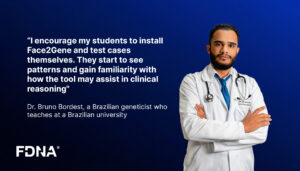May 22, 2016
M. A. Mensah, N. Hajjir, N. Ehmke, F. Alisch, C. Ott, R. Flöttmann, M. Spielmann, A. Thorwarth, D. Korinth, P. N. Robinson, S. Köhler, T. Zemojtel, P. Lorini, K. Dathe, S. Dölken, M. Schülke-Gerstenfeld, S. Mundlos, L. Graul-Neumann, D. Horn, P. M. Krawitz
Abstract
The combination of phenotype and genotype-based prioritization strategies proved to be highly effective for detecting disease-causing mutations in high-throughput sequencing studies. However, the performance of these approaches also depends on the precision of the clinical description and requires some expert knowledge. Facial recognition technology, that detects dysmorphic features from two-dimensional photographs, holds the promise to assist in deep phenotyping of syndromic patients. Therefore, we evaluated the syndrome predictions of image analyses in a cohort of more than 100 patients with a diverse spectrum of confirmed molecular diagnoses of monogenic disorders with the Facial dysmorphology Novel Analysis (FDNA) technology. Automated facial recognition yields the correct diagnosis amongst the first ten suggested syndromes in more than two-thirds of the cases and shows a high correlation with syndrome predictions that were based on expert annotated features. Hereby, we could confirm the diagnosis in cases with only subtle facial features amongst them patients with Rothmund-Thomson syndrome, Mowat-Wilson syndrome, Ectodermal Dysplasia, Fragile X syndrome, Rubinstein-Taybi syndrome, and Mabry syndrome. When exome data of patients was filtered for rare sequence variants and intersected with genes that were associated with the likeliest syndromes according to image analysis, the pathogenic mutations could be identified in all cases with few false positives. Our results show that computer-assisted facial recognition is not only a promising technology that could be applied in the routine diagnostic workflow but also a technology that allows diagnosis in cases with non-typical clinical presentation.


